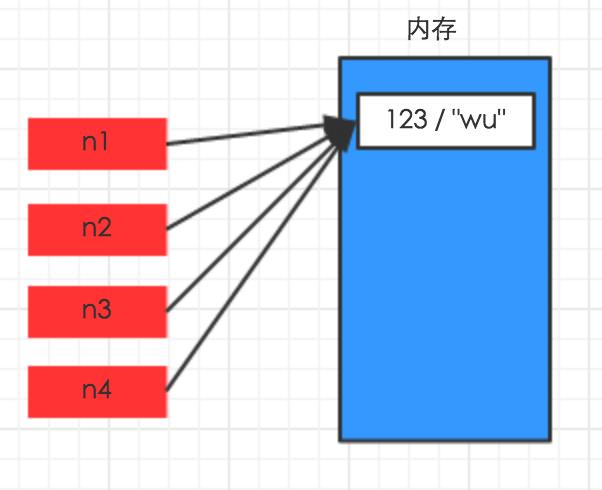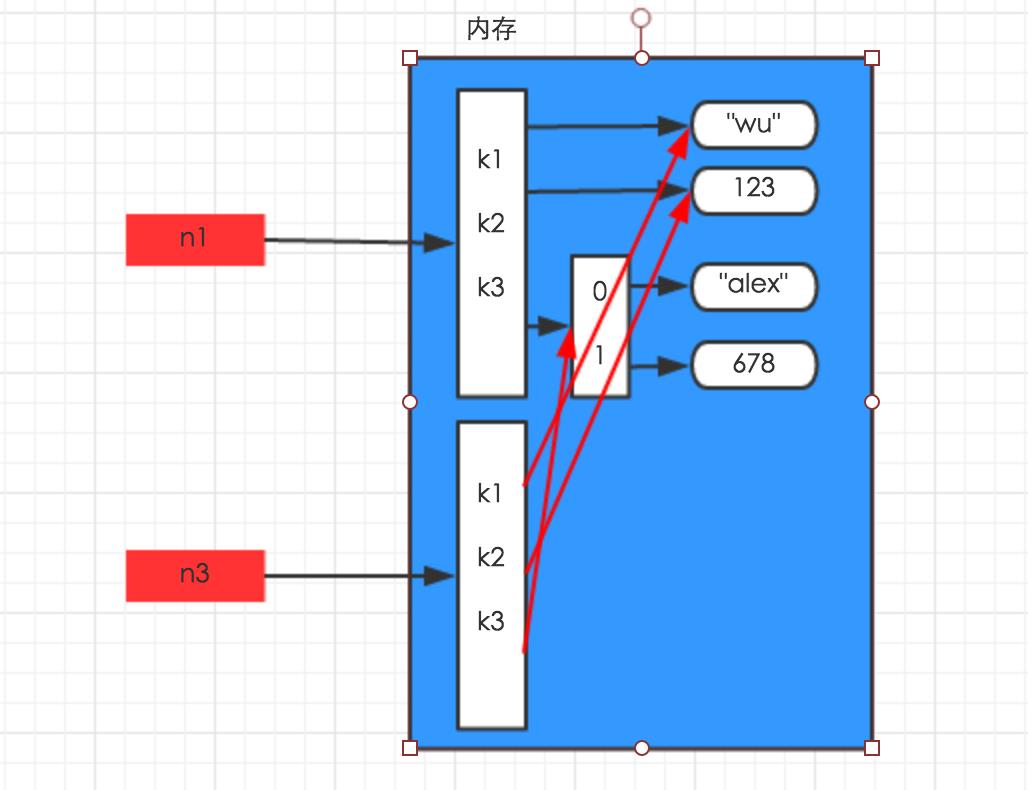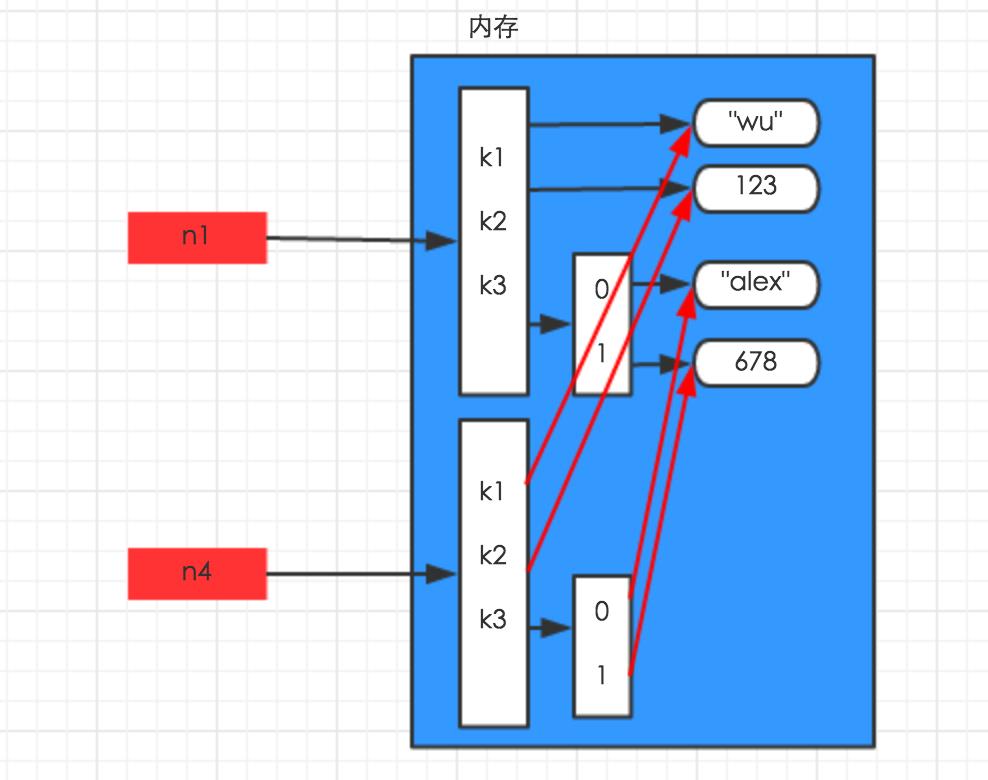三元运算
三元运算(三目运算),是对简单的条件语句的缩写。
|
1
2
3
4
5
|
# 书写格式result = 值1 if 条件 else 值2# 如果条件成立,那么将 “值1” 赋值给result变量,否则,将“值2”赋值给result变量 |
基本数据类型补充
set
set集合,是一个无序且不重复的元素集合
|
1
2
3
4
5
6
7
8
9
10
11
12
13
14
15
16
17
18
19
20
21
22
23
24
25
26
27
28
29
30
31
32
33
34
35
36
37
38
39
40
41
42
43
44
45
46
47
48
49
50
51
52
53
54
55
56
57
58
59
60
61
62
63
64
65
66
67
68
69
70
71
72
73
74
75
76
77
78
79
80
81
82
83
84
85
86
87
88
89
90
91
92
93
94
95
96
97
98
99
100
101
102
103
104
105
|
class set(object): """ set() -> new empty set object set(iterable) -> new set object Build an unordered collection of unique elements. """ def add(self, *args, **kwargs): # real signature unknown """ Add an element to a set,添加元素 This has no effect if the element is already present. """ pass def clear(self, *args, **kwargs): # real signature unknown """ Remove all elements from this set. 清除内容""" pass def copy(self, *args, **kwargs): # real signature unknown """ Return a shallow copy of a set. 浅拷贝 """ pass def difference(self, *args, **kwargs): # real signature unknown """ Return the difference of two or more sets as a new set. A中存在,B中不存在 (i.e. all elements that are in this set but not the others.) """ pass def difference_update(self, *args, **kwargs): # real signature unknown """ Remove all elements of another set from this set. 从当前集合中删除和B中相同的元素""" pass def discard(self, *args, **kwargs): # real signature unknown """ Remove an element from a set if it is a member. If the element is not a member, do nothing. 移除指定元素,不存在不保错 """ pass def intersection(self, *args, **kwargs): # real signature unknown """ Return the intersection of two sets as a new set. 交集 (i.e. all elements that are in both sets.) """ pass def intersection_update(self, *args, **kwargs): # real signature unknown """ Update a set with the intersection of itself and another. 取交集并更更新到A中 """ pass def isdisjoint(self, *args, **kwargs): # real signature unknown """ Return True if two sets have a null intersection. 如果没有交集,返回True,否则返回False""" pass def issubset(self, *args, **kwargs): # real signature unknown """ Report whether another set contains this set. 是否是子序列""" pass def issuperset(self, *args, **kwargs): # real signature unknown """ Report whether this set contains another set. 是否是父序列""" pass def pop(self, *args, **kwargs): # real signature unknown """ Remove and return an arbitrary set element. Raises KeyError if the set is empty. 移除元素 """ pass def remove(self, *args, **kwargs): # real signature unknown """ Remove an element from a set; it must be a member. If the element is not a member, raise a KeyError. 移除指定元素,不存在保错 """ pass def symmetric_difference(self, *args, **kwargs): # real signature unknown """ Return the symmetric difference of two sets as a new set. 对称差集 (i.e. all elements that are in exactly one of the sets.) """ pass def symmetric_difference_update(self, *args, **kwargs): # real signature unknown """ Update a set with the symmetric difference of itself and another. 对称差集,并更新到a中 """ pass def union(self, *args, **kwargs): # real signature unknown """ Return the union of sets as a new set. 并集 (i.e. all elements that are in either set.) """ pass def update(self, *args, **kwargs): # real signature unknown """ Update a set with the union of itself and others. 更新 """ pass |
练习:寻找差异
|
1
2
3
4
5
6
7
8
9
10
11
12
13
|
# 数据库中原有old_dict = { "#1":{ \'hostname\':c1, \'cpu_count\': 2, \'mem_capicity\': 80 }, "#2":{ \'hostname\':c1, \'cpu_count\': 2, \'mem_capicity\': 80 } "#3":{ \'hostname\':c1, \'cpu_count\': 2, \'mem_capicity\': 80 }} # cmdb 新汇报的数据new_dict = { "#1":{ \'hostname\':c1, \'cpu_count\': 2, \'mem_capicity\': 800 }, "#3":{ \'hostname\':c1, \'cpu_count\': 2, \'mem_capicity\': 80 } "#4":{ \'hostname\':c2, \'cpu_count\': 2, \'mem_capicity\': 80 }} |
需要删除:?需要新建:?需要更新:?
注意:无需考虑内部元素是否改变,只要原来存在,新汇报也存在,就是需要更新
深浅拷贝
一、数字和字符串
对于 数字 和 字符串 而言,赋值、浅拷贝和深拷贝无意义,因为其永远指向同一个内存地址。
|
1
2
3
4
5
6
7
8
9
10
11
12
13
14
15
|
import copy# ######### 数字、字符串 #########n1 = 123# n1 = "i am alex age 10"print(id(n1))# ## 赋值 ##n2 = n1print(id(n2))# ## 浅拷贝 ##n2 = copy.copy(n1)print(id(n2)) # ## 深拷贝 ##n3 = copy.deepcopy(n1)print(id(n3)) |

二、其他基本数据类型
对于字典、元祖、列表 而言,进行赋值、浅拷贝和深拷贝时,其内存地址的变化是不同的。
1、赋值
赋值,只是创建一个变量,该变量指向原来内存地址,如:
|
1
2
3
|
n1 = {"k1": "wu", "k2": 123, "k3": ["alex", 456]} n2 = n1 |

2、浅拷贝
浅拷贝,在内存中只额外创建第一层数据
|
1
2
3
4
5
|
import copy n1 = {"k1": "wu", "k2": 123, "k3": ["alex", 456]} n3 = copy.copy(n1) |

3、深拷贝
深拷贝,在内存中将所有的数据重新创建一份(排除最后一层,即:python内部对字符串和数字的优化)
|
1
2
3
4
5
|
import copy n1 = {"k1": "wu", "k2": 123, "k3": ["alex", 456]} n4 = copy.deepcopy(n1) |

函数
一、背景
在学习函数之前,一直遵循:面向过程编程,即:根据业务逻辑从上到下实现功能,其往往用一长段代码来实现指定功能,开发过程中最常见的操作就是粘贴复制,也就是将之前实现的代码块复制到现需功能处,如下:
|
1
2
3
4
5
6
7
8
9
10
11
12
13
14
15
16
17
18
|
while True: if cpu利用率 > 90%: #发送邮件提醒 连接邮箱服务器 发送邮件 关闭连接 if 硬盘使用空间 > 90%: #发送邮件提醒 连接邮箱服务器 发送邮件 关闭连接 if 内存占用 > 80%: #发送邮件提醒 连接邮箱服务器 发送邮件 关闭连接 |
腚眼一看上述代码,if条件语句下的内容可以被提取出来公用,如下:
|
1
2
3
4
5
6
7
8
9
10
11
12
13
14
15
|
def 发送邮件(内容) #发送邮件提醒 连接邮箱服务器 发送邮件 关闭连接 while True: if cpu利用率 > 90%: 发送邮件(\'CPU报警\') if 硬盘使用空间 > 90%: 发送邮件(\'硬盘报警\') if 内存占用 > 80%: |
对于上述的两种实现方式,第二次必然比第一次的重用性和可读性要好,其实这就是函数式编程和面向过程编程的区别:
- 函数式:将某功能代码封装到函数中,日后便无需重复编写,仅调用函数即可
- 面向对象:对函数进行分类和封装,让开发“更快更好更强...”
函数式编程最重要的是增强代码的重用性和可读性
二、定义和使用
|
1
2
3
4
5
6
|
def 函数名(参数): ... 函数体 ... 返回值 |
函数的定义主要有如下要点:
- def:表示函数的关键字
- 函数名:函数的名称,日后根据函数名调用函数
- 函数体:函数中进行一系列的逻辑计算,如:发送邮件、计算出 [11,22,38,888,2]中的最大数等...
- 参数:为函数体提供数据
- 返回值:当函数执行完毕后,可以给调用者返回数据。
1、返回值
函数是一个功能块,该功能到底执行成功与否,需要通过返回值来告知调用者。
以上要点中,比较重要有参数和返回值:
|
1
2
3
4
5
6
7
8
9
10
11
12
13
14
15
16
17
18
|
def 发送短信(): 发送短信的代码... if 发送成功: return True else: return False while True: # 每次执行发送短信函数,都会将返回值自动赋值给result # 之后,可以根据result来写日志,或重发等操作 result = 发送短信() if result == False: 记录日志,短信发送失败... |
2、参数
为什么要有参数?

def CPU报警邮件()
#发送邮件提醒
连接邮箱服务器
发送邮件
关闭连接
def 硬盘报警邮件()
#发送邮件提醒
连接邮箱服务器
发送邮件
关闭连接
def 内存报警邮件()
#发送邮件提醒
连接邮箱服务器
发送邮件
关闭连接
while True:
if cpu利用率 > 90%:
CPU报警邮件()
if 硬盘使用空间 > 90%:
硬盘报警邮件()
if 内存占用 > 80%:
内存报警邮件()

def 发送邮件(邮件内容)
#发送邮件提醒
连接邮箱服务器
发送邮件
关闭连接
while True:
if cpu利用率 > 90%:
发送邮件("CPU报警了。")
if 硬盘使用空间 > 90%:
发送邮件("硬盘报警了。")
if 内存占用 > 80%:
发送邮件("内存报警了。")
函数的有三中不同的参数:
- 普通参数
- 默认参数
- 动态参数

# ######### 定义函数 #########
# name 叫做函数func的形式参数,简称:形参
def func(name):
print name
# ######### 执行函数 #########
# \'wupeiqi\' 叫做函数func的实际参数,简称:实参
func(\'wupeiqi\')

